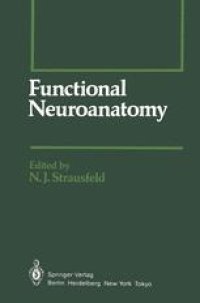
Ebook: Functional Neuroanatomy
- Tags: Neurosciences, Computer Graphics, Zoology, Cell Biology, Biochemistry general
- Series: Springer Series in Experimental Entomology
- Year: 1983
- Publisher: Springer-Verlag Berlin Heidelberg
- Edition: 1
- Language: English
- pdf
The "functional" in the title of this book not only reflects my personal bias about neuroanatomy in brain research, it is also the gist of many chapters which describe sophisticated ways to resolve structures and interpret them as dynamic entities. Examples are: the visualization of functionally identified brain areas or neurons by activity staining or intracellular dye-iontophoresis; the resolution of synaptic connections between physiologically identified nerve cells; and the biochemical identification of specific neurons (their peptides and transmitters) by histo- and immunocytochemistry. I personally view the nervous system as an organ whose parts, continuously exchanging messages, arrive at their decisions by the cooperative phenome non of consensus and debate. This view is, admittedly, based on my own ex perience of looking at myriads of nerve cells and their connections rather than studying animal behaviour or theorizing. Numerous structural studies have demonstrated that interneurons in the brain must receive hundreds of thousands of synapses. Many neurons receive inputs from several different sensory areas: each input conveys a message about the external world and possibly also about past events which are stored within the central nervous system. Whether an interneuron responds to a certain combination of inputs may be, literally, a matter of debate whose outcome is decided at the post synaptic membrane. A nerve cell responding to an overriding command is possibly a rare event.
Content:
Front Matter....Pages I-XVI
Electron Microscopy of Golgi-Impregnated Neurons....Pages 1-18
Block Intensification and X-Ray Microanalysis of Cobalt-Filled Neurons for Electron Microscopy....Pages 19-43
Horseradish Peroxidase and Other Heme Proteins as Neuronal Markers....Pages 44-91
Intracellular Staining with Nickel Chloride....Pages 92-95
Rubeanic Acid and X-Ray Microanalysis for Demonstrating Metal Ions in Filled Neurons....Pages 96-111
Double Marking for Light and Electron Microscopy....Pages 112-131
Lucifer Yellow Histology....Pages 132-155
Portraying the Third Dimension in Neuroanatomy....Pages 156-182
Three-Dimensional Reconstruction and Stereoscopic Display of Neurons in the Fly Visual System....Pages 183-205
Laser Microsurgery for the Study of Behaviour and Neural Development of Flies....Pages 206-224
Anatomical Localization of Functional Activity in Flies Using 3H-2-Deoxy-d-Glucose....Pages 225-238
Strategies for the Identification of Amine- and Peptide-Containing Neurons....Pages 239-249
Immunochemical Identification of Vertebrate-Type Brain-Gut Peptides in Insect Nerve Cells....Pages 250-266
Immunocytochemical Techniques for the Identification of Peptidergic Neurons....Pages 267-301
Detection of Serotonin-Containing Neurons in the Insect Nervous System by Antibodies to 5-HT....Pages 302-316
Monoaminergic Innervation in a Hemipteran Nervous System: A Whole-Mount Histofluorescence Survey....Pages 317-330
Identification of Neurons Containing Vertebrate-Type Brain-Gut Peptides by Antibody and Cobalt Labelling....Pages 331-338
Interpretation of Freeze-Fracture Replicas of Insect Nervous Tissue....Pages 339-375
High-Voltage Electron Microscopy for Insect Neuroanatomy....Pages 376-385
Back Matter....Pages 386-428
Content:
Front Matter....Pages I-XVI
Electron Microscopy of Golgi-Impregnated Neurons....Pages 1-18
Block Intensification and X-Ray Microanalysis of Cobalt-Filled Neurons for Electron Microscopy....Pages 19-43
Horseradish Peroxidase and Other Heme Proteins as Neuronal Markers....Pages 44-91
Intracellular Staining with Nickel Chloride....Pages 92-95
Rubeanic Acid and X-Ray Microanalysis for Demonstrating Metal Ions in Filled Neurons....Pages 96-111
Double Marking for Light and Electron Microscopy....Pages 112-131
Lucifer Yellow Histology....Pages 132-155
Portraying the Third Dimension in Neuroanatomy....Pages 156-182
Three-Dimensional Reconstruction and Stereoscopic Display of Neurons in the Fly Visual System....Pages 183-205
Laser Microsurgery for the Study of Behaviour and Neural Development of Flies....Pages 206-224
Anatomical Localization of Functional Activity in Flies Using 3H-2-Deoxy-d-Glucose....Pages 225-238
Strategies for the Identification of Amine- and Peptide-Containing Neurons....Pages 239-249
Immunochemical Identification of Vertebrate-Type Brain-Gut Peptides in Insect Nerve Cells....Pages 250-266
Immunocytochemical Techniques for the Identification of Peptidergic Neurons....Pages 267-301
Detection of Serotonin-Containing Neurons in the Insect Nervous System by Antibodies to 5-HT....Pages 302-316
Monoaminergic Innervation in a Hemipteran Nervous System: A Whole-Mount Histofluorescence Survey....Pages 317-330
Identification of Neurons Containing Vertebrate-Type Brain-Gut Peptides by Antibody and Cobalt Labelling....Pages 331-338
Interpretation of Freeze-Fracture Replicas of Insect Nervous Tissue....Pages 339-375
High-Voltage Electron Microscopy for Insect Neuroanatomy....Pages 376-385
Back Matter....Pages 386-428
....